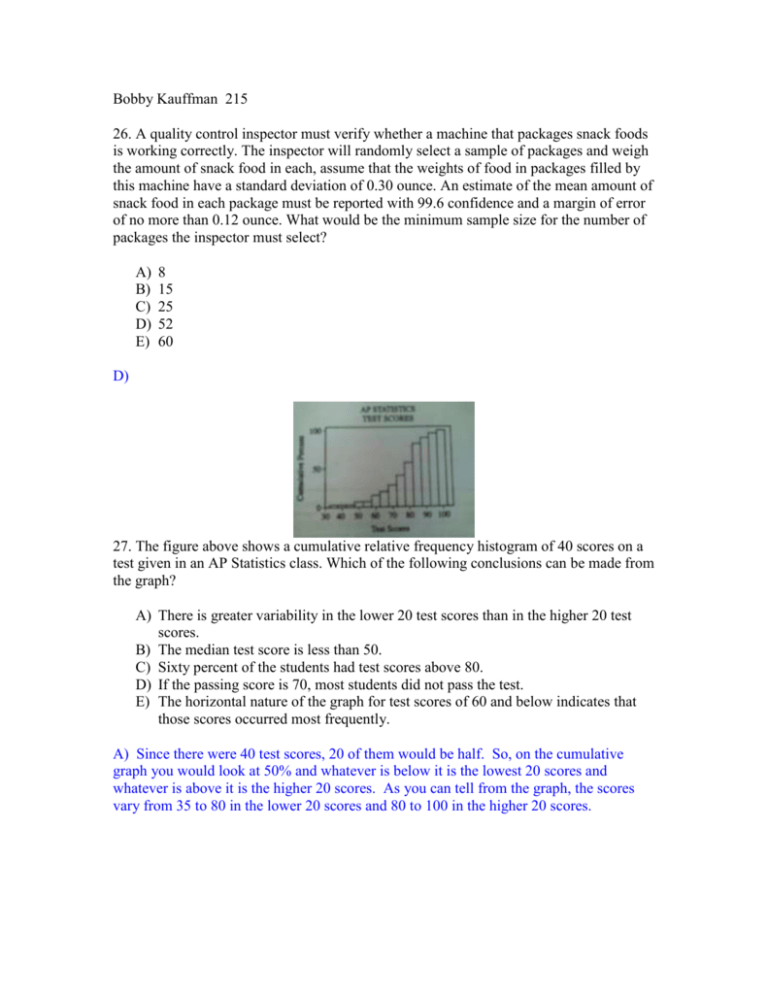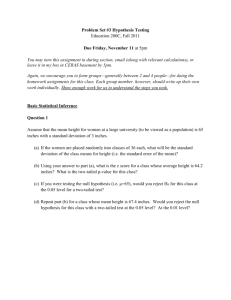2002_APSTATS_MC 26,27,28,29,30
advertisement

Bobby Kauffman 215
26. A quality control inspector must verify whether a machine that packages snack foods
is working correctly. The inspector will randomly select a sample of packages and weigh
the amount of snack food in each, assume that the weights of food in packages filled by
this machine have a standard deviation of 0.30 ounce. An estimate of the mean amount of
snack food in each package must be reported with 99.6 confidence and a margin of error
of no more than 0.12 ounce. What would be the minimum sample size for the number of
packages the inspector must select?
A)
B)
C)
D)
E)
8
15
25
52
60
D)
27. The figure above shows a cumulative relative frequency histogram of 40 scores on a
test given in an AP Statistics class. Which of the following conclusions can be made from
the graph?
A) There is greater variability in the lower 20 test scores than in the higher 20 test
scores.
B) The median test score is less than 50.
C) Sixty percent of the students had test scores above 80.
D) If the passing score is 70, most students did not pass the test.
E) The horizontal nature of the graph for test scores of 60 and below indicates that
those scores occurred most frequently.
A) Since there were 40 test scores, 20 of them would be half. So, on the cumulative
graph you would look at 50% and whatever is below it is the lowest 20 scores and
whatever is above it is the higher 20 scores. As you can tell from the graph, the scores
vary from 35 to 80 in the lower 20 scores and 80 to 100 in the higher 20 scores.
28. Two measures x and y were taken on 18 subjects. The first of two regressions,
Regression I, yielded y hat = 24.5 + 16.1x and had the following residual plot.
8
6
4
2
0
-2
-4
-6
-8
.5
1
1.5
2
2.5
3
The second regression, Regression II, yielded log(y) hat = 1.6 + 0.51 log(x) and had the
following residual plot.
.05
.03
.01
-.01
-.03
-.05
-.343
-.186
-.029
.129
.286
.443
.6
Which of the following conclusions is best supported by the evidence above?
A)
B)
C)
D)
E)
There is a linear relationship between x and y, and Regression I yields a better fit.
There is a linear relationship between x and y, and Regression II yields a better fit.
There is a negative correlation between x and y.
There is a nonlinear relationship between x and y, and Regression I yields a better fit.
There is a nonlinear relationship between x and y, and Regression II yields a better fit.
E) By looking at the graphs you can tell that the data is nonlinear. Residuals are the
distance of the points from the line. If you look at the scale of the two graphs, the second
graph is much closer to 0 than the first graph.
29. The analysis of a random sample of 500 households in a suburb of a large city
indicates that a 98 percent confidence interval for the mean family income is ($41,300,
$58,630). Could this information be used to conduct a test of the null hypothesis H0: =
40,000 against the alternative hypothesis Ha: 40,000 at the = 0.02 level of
significance?
No, because the value of is unknown.
No, because it is not known whether the data are normally distributed.
No, because the entire data set is needed to do this test.
Yes, since $40,000 is not contained in the 98 percent confidence interval, the null
hypothesis would be rejected in favor of the alternative, and it could be concluded
that the mean family income is significantly different from $40,000 at the =
0.02 level.
E) Yes, since $40,000 is not contained in the 98 percent confidence interval, the null
hypothesis would not be rejected in favor of the alternative, and it could be
concluded that the mean family income is not significantly different from $40,000
at the = 0.02 level.
A)
B)
C)
D)
D) The 98% confidence interval includes all of the values that would make you accept
the null given that the null was one of the values within the confidence interval. Since,
40,000 is not included in the given confidence interval ($41,300, $58,630), you would
reject the null hypothesis at this given confidence interval.
30.
The population {2,3,5,7} has mean = 4.25 and standard deviation = 1.92.
When sampling with replacement, there are 16 different possible ordered samples of size
2 that can be selected from this population. The mean of each of these 16 samples is
computed. For example, 1 of the 16 samples is (2,5), which has a mean of 3.5. The
distribution of the 16 sample means has its own mean
. Which of the following statements is true?
x
A) 4.25 and 1.92
x
x
x
x
B) 4.25 and 1.92
C) 4.25 and 1.92
x
D) 4.25
x
E) 4.25
x
x
x
and its own standard deviation
C) The mean stays the same because it is just the average. The standard deviation of x
bar would be less than the standard deviation of the population because you have a bigger
chance to pick some numbers that average out to the mean with 2 picks then you would
with 1 pick. Basically the variation decreases in the sample size, thus reducing the
standard deviation.






